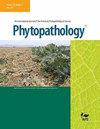求助PDF
{"title":"布基纳法索柑橘生产中柑橘黄单胞菌(Xanthomonas citri pv. citri)菌株的遗传变异和地理分布模式分析。","authors":"Kevin Ben Fabrice Zerbo, Florence Yameogo, Issa Wonni, Irénée Somda","doi":"10.1094/PHYTO-04-24-0121-R","DOIUrl":null,"url":null,"abstract":"<p><p>It is essential to have a thorough knowledge of the genetic variation among different strains of <i>Xanthomonas citri</i> pv. <i>citri</i>, which is responsible for causing citrus bacterial canker. This understanding is important for studying disease characteristics, population structure, and evolution and ultimately for developing sustainable methods of control. A total of 48 strains obtained from citrus production areas in Burkina Faso in 2012, 2020, and 2021 were subjected to Polymerase Chain reaction (PCR) tests using specific primers. The aim was to examine the distribution of type 3 effectors and determine the geographical origins of the strains. The examination of the distribution of type 3 non-transcription-activator-like effectors (TALEs) revealed a broader range of strains obtained in 2020 and 2021 than in 2012. However, all the strains possessed a shared set of three genes, specifically, XopE2, XopN, and AvrBs2. Furthermore, all examined effectors were observed in the Bobo-Dioulasso region. Regarding the characterization of TALEs, two profiles containing two to three TALEs were discovered. Profile 1, consisting of two TALEs, was found in 37 <i>X. citri</i> pv. <i>citri</i> strains, whereas Profile 2, comprising three TALEs, was detected in 11 strains. Among the three TALEs (A, B, and C) that were identified, TALEs B and C were present in all the strains. The correlation matrix indicated a positive association between the type 3 effector content of strains and the duration of their isolation. Principal component analysis revealed a limited organization of the strains under investigation. [Formula: see text] Copyright © 2024 The Author(s). This is an open access article distributed under the CC BY-NC-ND 4.0 International license.</p>","PeriodicalId":20410,"journal":{"name":"Phytopathology","volume":" ","pages":"2024-2032"},"PeriodicalIF":2.6000,"publicationDate":"2024-09-01","publicationTypes":"Journal Article","fieldsOfStudy":null,"isOpenAccess":false,"openAccessPdf":"","citationCount":"0","resultStr":"{\"title\":\"Analysis of the Genetic Variation and Geographic Distribution Patterns of <i>Xanthomonas citri</i> pv. <i>citri</i> Strains in Citrus Production in Burkina Faso.\",\"authors\":\"Kevin Ben Fabrice Zerbo, Florence Yameogo, Issa Wonni, Irénée Somda\",\"doi\":\"10.1094/PHYTO-04-24-0121-R\",\"DOIUrl\":null,\"url\":null,\"abstract\":\"<p><p>It is essential to have a thorough knowledge of the genetic variation among different strains of <i>Xanthomonas citri</i> pv. <i>citri</i>, which is responsible for causing citrus bacterial canker. This understanding is important for studying disease characteristics, population structure, and evolution and ultimately for developing sustainable methods of control. A total of 48 strains obtained from citrus production areas in Burkina Faso in 2012, 2020, and 2021 were subjected to Polymerase Chain reaction (PCR) tests using specific primers. The aim was to examine the distribution of type 3 effectors and determine the geographical origins of the strains. The examination of the distribution of type 3 non-transcription-activator-like effectors (TALEs) revealed a broader range of strains obtained in 2020 and 2021 than in 2012. However, all the strains possessed a shared set of three genes, specifically, XopE2, XopN, and AvrBs2. Furthermore, all examined effectors were observed in the Bobo-Dioulasso region. Regarding the characterization of TALEs, two profiles containing two to three TALEs were discovered. Profile 1, consisting of two TALEs, was found in 37 <i>X. citri</i> pv. <i>citri</i> strains, whereas Profile 2, comprising three TALEs, was detected in 11 strains. Among the three TALEs (A, B, and C) that were identified, TALEs B and C were present in all the strains. The correlation matrix indicated a positive association between the type 3 effector content of strains and the duration of their isolation. Principal component analysis revealed a limited organization of the strains under investigation. [Formula: see text] Copyright © 2024 The Author(s). This is an open access article distributed under the CC BY-NC-ND 4.0 International license.</p>\",\"PeriodicalId\":20410,\"journal\":{\"name\":\"Phytopathology\",\"volume\":\" \",\"pages\":\"2024-2032\"},\"PeriodicalIF\":2.6000,\"publicationDate\":\"2024-09-01\",\"publicationTypes\":\"Journal Article\",\"fieldsOfStudy\":null,\"isOpenAccess\":false,\"openAccessPdf\":\"\",\"citationCount\":\"0\",\"resultStr\":null,\"platform\":\"Semanticscholar\",\"paperid\":null,\"PeriodicalName\":\"Phytopathology\",\"FirstCategoryId\":\"97\",\"ListUrlMain\":\"https://doi.org/10.1094/PHYTO-04-24-0121-R\",\"RegionNum\":2,\"RegionCategory\":\"农林科学\",\"ArticlePicture\":[],\"TitleCN\":null,\"AbstractTextCN\":null,\"PMCID\":null,\"EPubDate\":\"2024/8/14 0:00:00\",\"PubModel\":\"Epub\",\"JCR\":\"Q2\",\"JCRName\":\"PLANT SCIENCES\",\"Score\":null,\"Total\":0}","platform":"Semanticscholar","paperid":null,"PeriodicalName":"Phytopathology","FirstCategoryId":"97","ListUrlMain":"https://doi.org/10.1094/PHYTO-04-24-0121-R","RegionNum":2,"RegionCategory":"农林科学","ArticlePicture":[],"TitleCN":null,"AbstractTextCN":null,"PMCID":null,"EPubDate":"2024/8/14 0:00:00","PubModel":"Epub","JCR":"Q2","JCRName":"PLANT SCIENCES","Score":null,"Total":0}
引用次数: 0
引用
批量引用


